The Severed Head: Capital Visions by Julia Kristeva

Author:Julia Kristeva [Kristeva, Julia]
Language: eng
Format: azw3
Tags: Philosophy, Nonfiction, Aesthetics
ISBN: 0231157207
Publisher: Columbia University Press
Published: 1998-01-01T00:00:00+00:00
7
BEHEADINGS
John the Baptist, prefigurer par excellence, lends his figure to the figuration of the invisible par excellence: the passage.
Figuration is now ready to accommodate the mythical and biblical memory of beheadings. Because a history of decapitation really does exist in the various civilizations, one that is coming to be reconstructed.1 Texts, legends, fantasies detail a thousand and one variations of severed heads. Their historical significance and local color echo the tormented vision of the artist who claims them and brings them back to life, each time contemporary in the graphic cut or crimson tint of his works. The graphic artist relies heavily on supposedly familiar texts, which the viewer is implicitly commended to read, but that are found in the drawing, more or less freely interpreted, realized, in the strict sense of the word, âfigured.â In the give-and-take between past and present, text and image, that constitutes the Figureâs cunning, the representation of our pathetic excess finds itself exonerated: slaughter turned to image assuages the violence, more or less repressed or mastered, of individuals and nations. In so doing, this genre of representations secretly imposes a new metaphysics that could possibly be an antimetaphysics. It is a matter of examining the sacrificial limits of visibility itself through the means of figuration, thus of visiting the economy of transfigurationâalchemy in which the representation comes of a grieving, a renunciation, a castration, a death. There is something beyond death, the artistic experience says, there is resurrection: it is nothing other than the life of the line, the elegance of the gesture, the grace or brutality of colors, when they dare to show the human threshold. Decapitation is a privileged space. Exultate, jubilate!
With a nervous, implacably parsimonious line, Luca Cambiaso captures Mercury preparing to cut off Argusâs head. He no doubt knew that Argus, or Argos, the prince of Argos and son of Medea, had a hundred eyes and bore the nickname of Panoptes the Luminous, âall eyes.â Mercury-Hermes, the winged god of travelers and merchants, managed to put him to sleep with the sound of his flute and kill him. Hera, who had put him in charge of guarding the cow Io, then sowed his eyes in the peacockâs tail. A hundred eyes or a hundred heads? That was the question Max Ernst would ask much later, but with regard to a woman.2 The Greco-Roman legend here is only a drawing by Cambiaso. The painter is transfigured into the man with the hundred eyes. Is that Argus we see, suppliant at the bottom of the page, or is it Cambiaso, who offers himself as torture victim to the Mercury of his fantasies, of his love? Differently from psychoanalysis, the aesthetic experience too revisits and exhausts the logic of the sacred.
The young David cutting off the head of the monster Goliath is no longer simply a text.3 From the many complex adventures in the life of this biblical king, who, in his youth, came to the aid of King Saul to fight the
Download
This site does not store any files on its server. We only index and link to content provided by other sites. Please contact the content providers to delete copyright contents if any and email us, we'll remove relevant links or contents immediately.
Papillon by Henry Charrière(793)
Watercolor With Me in the Forest by Dana Fox(588)
The Story of the Scrolls by The Story of the Scrolls; the M(556)
This Is Modern Art by Kevin Coval(456)
A Theory of Narrative Drawing by Simon Grennan(453)
Frida Kahlo by Frida Kahlo & Hayden Herrera(445)
Boris Johnson by Tom Bower(442)
Banksy by Will Ellsworth-Jones(434)
AP Art History by John B. Nici(428)
Van Gogh by Gregory White Smith(425)
Draw More Furries by Jared Hodges(422)
The Art and Science of Drawing by Brent Eviston(420)
Glittering Images: A Journey Through Art From Egypt to Star Wars by Camille Paglia(416)
Scenes From a Revolution by Mark Harris(411)
War Paint by Woodhead Lindy(411)
100 Greatest Country Artists by Hal Leonard Corp(391)
Ecstasy by Eisner.;(386)
Young Rembrandt: A Biography by Onno Blom(371)
Theater by Rene Girard(354)
